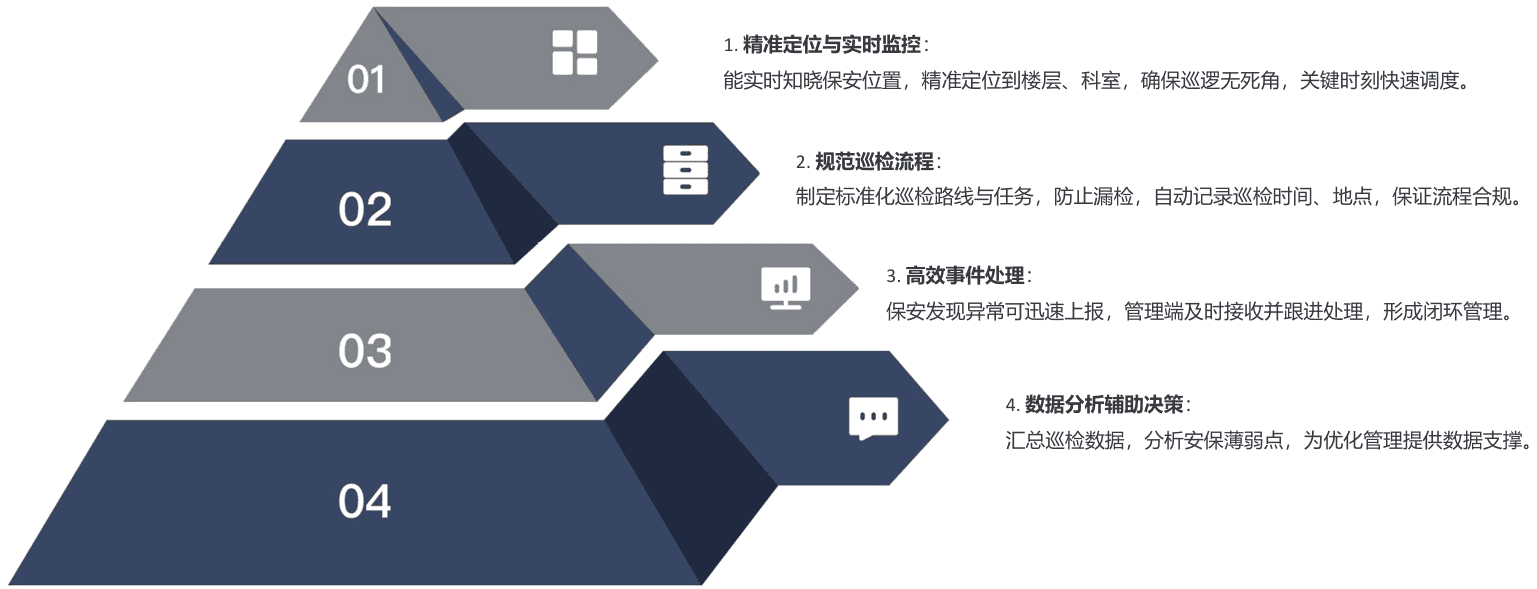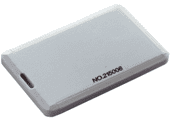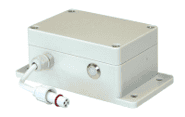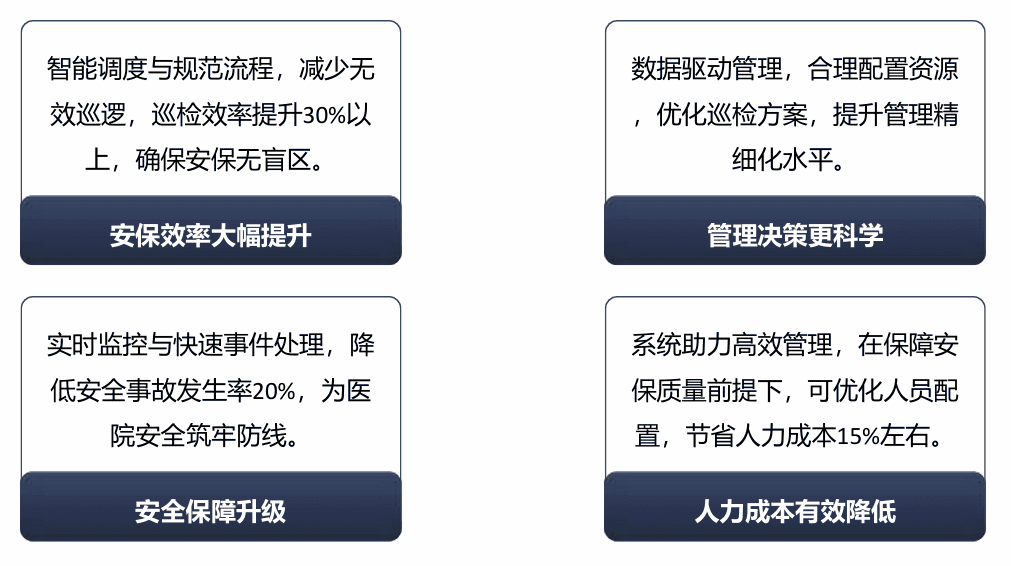I. Background of the project
As a densely populated place with valuable equipment and extremely high security requirements, hospitals have a crucial role to play in day-to-day security work. Traditional security inspection relies on manual records, easy to miss, wrong inspection, and can not be real-time monitoring, security risks are difficult to detect in a timely manner. In order to improve the security level of hospitals, the introduction of intelligent inspection management program is imminent.
II. Needs analysis

III. System architecture
- Sensory Layer: Dual Frequency Activator::
- Dual-frequency activators are deployed at 10-15 meter intervals in various key areas of the hospital, such as ward areas, emergency rooms, pharmacies, equipment rooms, parking lot entrances and exits. The activators are battery-powered, with low power consumption, strong signal, waterproof and dustproof, and can be installed magnetically or wall-mounted, with a signal coverage radius of 2-10 meters, accurately marking inspection points.
- Sensing layer: network base stations::
- Network base stations are installed within 50-100 meters of each area of the hospital for receiving tag signals in the area.
- Sensing Layer: Intelligent Terminal::
- Equipped with customized tags for the security guards, using the tag type ZigBee dual-frequency location tags will start to work when they encounter an activator nearby, sending their own ID and the activator ID to the network reading base station, which reports the data to the management platform through the hospital's existing network (Ethernet or 4G/5G). Security personnel use cell phone APP to communicate with the management platform in real time through 4G/5G network.
- transport layer::
- Utilizing the existing 4G/5G network of the hospital, it guarantees stable and high-speed transmission of data between the smartphone APP and the management platform to ensure timely delivery of location information, event reporting and other data.
- application layer (computing)::
- Build an intelligent inspection management platform based on cloud servers, with modules for user management, task management, real-time monitoring, event processing, data analysis and so on. Managers can log in to the platform via PC and mobile webpage to conveniently operate various functions.
IV. Hardware products

tab (of a window) (computing) WE-T28K125
- Battery type: 2pcs CR2032 button batteries
- Activation sensitivity: 80uVRMS
- Activated range: 2-10 meters
- Operating frequency band: 2.4GHz; 125K
- Working time: >3 years
- Protection class: IP65, rainproof
- Weight: 20G
- Working temperature: -20~60℃ Overall dimensions: 83mm*52mm*5.8mm

wireless base stationWE-TX125
- Simultaneous activation of tags: 500
- Activation distance: 3-6 meters adjustable
- Transmit power: less than 100 mW (1 meter)
- Carrier frequency: -125K
- Extension cord: 3 meters
- Supply voltage: DC10V-DC26V
- Current consumption: less than 150mA
- Protection class: IP67
- Weight: 260g
- Size: 100mm × 68mm × 50mm
- Working Temperature: -40℃~+85℃

WLAN base stationWE-RN01
- Simultaneous detection of tags: 500
- Detection distance open: 100 meters
- Network port: 10M/100M adaptive
- Wireless Transmission Power: 30dBm
- Receiving sensitivity: -145dBm
- Extendable feeder length: 50 meters
- Supply voltage: DC10V-DC26V
- Current consumption: 800mA (12V)
- Weight: 250g
- Size: 82mm × 103mm × 33mm
- Working Temperature: -40℃~+85℃

placementserver (computer)WE-LS01
- CPU: Quad-core Cortex-A7 processor at 1.2GHz
- Memory: 1G RAM + 8G ROM
- Storage: 32GB
- Simultaneous detection of tags: 10000
- Simultaneous management of base stations: 500
- Network port: 10M/100M adaptive
- Supply voltage: 9V-DC30V (wide voltage)
- Weight: 1500g
- Size: 234mm × 200mm × 52mm
- Working temperature: -20℃~+60℃
V. Functional modules

VI. Implementation steps
- Project preparation (1 week)::
Communicate with multiple hospital departments to determine inspection priorities and needs; complete equipment selection and procurement; and form an implementation team with a clear division of labor. - Equipment deployment (2 weeks)::
Installation of dual-frequency activators and network base stations and debugging of signals as planned; issuance of dual-frequency tags for security guards, installation and debugging of APP, and completion of equipment and platform intermodulation. - Training of personnel (1 week)::
To carry out APP operation training for security guards, explaining the inspection process and event reporting specifications; to train managers in the use of the platform and familiarize them with the functions of data viewing and task scheduling. - Trial run optimization (2 weeks)::
Trial run of the system to collect feedback, solve problems such as unstable signal and inconvenient operation, and optimize the system. - Official launch (1 week)::
After the trial run meets the standard, it will be formally put on line. Provide technical support on an ongoing basis to ensure stable operation of the system.
VII. Expected benefits

Editor-in-Chief:Ameko Wu
Content Reviewer:Jimme Yao
Content Reviewer:Jimme Yao





